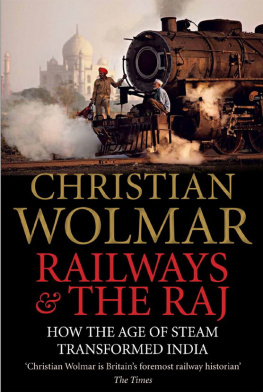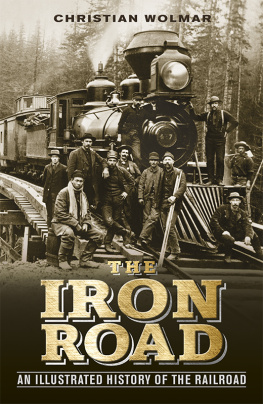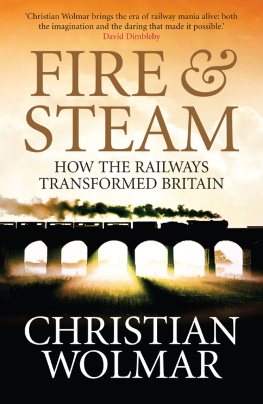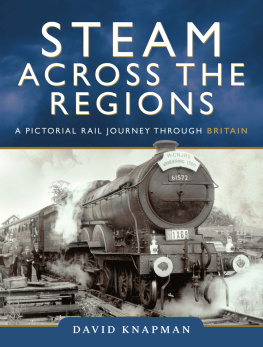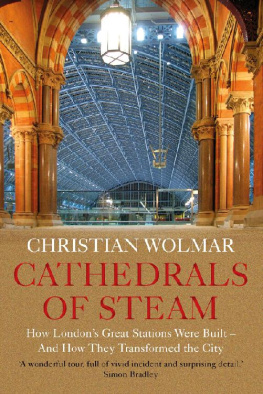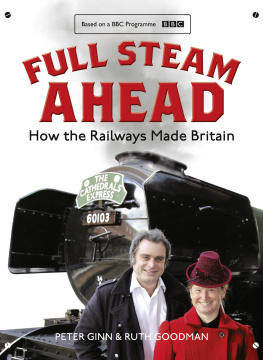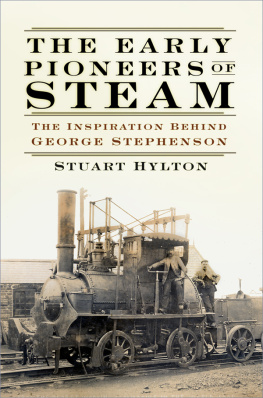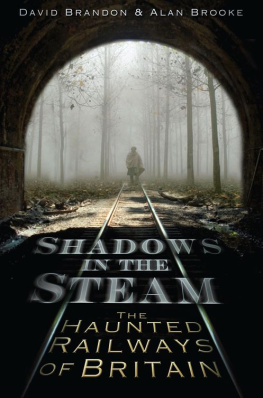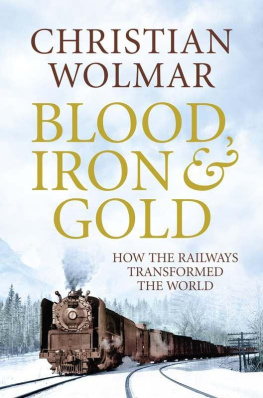Wolmar - Fire & steam how the railways transformed Britain
Here you can read online Wolmar - Fire & steam how the railways transformed Britain full text of the book (entire story) in english for free. Download pdf and epub, get meaning, cover and reviews about this ebook. City: London, year: 2008, publisher: Perseus Books, LLC;Atlantic, genre: Religion. Description of the work, (preface) as well as reviews are available. Best literature library LitArk.com created for fans of good reading and offers a wide selection of genres:
Romance novel
Science fiction
Adventure
Detective
Science
History
Home and family
Prose
Art
Politics
Computer
Non-fiction
Religion
Business
Children
Humor
Choose a favorite category and find really read worthwhile books. Enjoy immersion in the world of imagination, feel the emotions of the characters or learn something new for yourself, make an fascinating discovery.
Fire & steam how the railways transformed Britain: summary, description and annotation
We offer to read an annotation, description, summary or preface (depends on what the author of the book "Fire & steam how the railways transformed Britain" wrote himself). If you haven't found the necessary information about the book — write in the comments, we will try to find it.
Wolmar: author's other books
Who wrote Fire & steam how the railways transformed Britain? Find out the surname, the name of the author of the book and a list of all author's works by series.
Fire & steam how the railways transformed Britain — read online for free the complete book (whole text) full work
Below is the text of the book, divided by pages. System saving the place of the last page read, allows you to conveniently read the book "Fire & steam how the railways transformed Britain" online for free, without having to search again every time where you left off. Put a bookmark, and you can go to the page where you finished reading at any time.
Font size:
Interval:
Bookmark:

FIRE &
STEAM

First published in Great Britain in hardback in 2007 by Atlantic Books, an imprint of Grove Atlantic Ltd.
Copyright Christian Wolmar 2007
The moral right of Christian Wolmar to be identified as the author of this
work has been asserted in accordance with the Copyright, Designs and Patents
Act of 1988.
All rights reserved. No part of this publication may be reproduced, stored
in a retrieval system or transmitted in any form or by any means, electronic,
mechanical, photocopying, recording or otherwise, without the prior permission
of both the copyright owner and the above publisher of this book.
Every effort has been made to trace or contact all copyright-holders.
The publishers will be pleased to make good any omissions or rectify
any mistakes brought to their attention at the earliest opportunity.
9 8 7 6 5 4 3 2 1
A CIP catalogue record for this book is available from the British Library.
978 1 84354 629 0
ePub ISBN: 978 1 84887 261 5
Mobi ISBN 978 1 84887 261 5
1851 railway network map Jeff Edwards
All other maps Mark Rolfe Technical Art
Printed in Great Britain
Atlantic Books
An imprint of Grove Atlantic Ltd
Ormond House
2627 Boswell Street
London
WC1N 3JZ
Dedicated to my wonderful children, Molly Brooks,
Pascoe Sabido and Misha MccGwire, even though
they think I am a mad trainspotter, and to the Railway
Children, the charity that helps less fortunate children
around the world (www.railwaychildren.org.uk).
LIST OF MAPS AND ILLUSTRATIONS
MAPS |
ILLUSTRATIONS |
| 20. |
PREFACE
There was a great temptation to write a nostalgic book about the railways. The smell of oil and steam emanating from the massive Princess engines in the Willesden depot and the more compact Kings and Castles in Old Oak Common just down the road is still with me. And so is the memory of the policeman who shouted Oi, you and chased me around the back of the Willesden depot but lost out when I proved more nimble at jumping over the fence. My childhood is full of such tales as trainspotting was my escape from my mothers overcleaned flat in Kensington. My journeys with Mr Potters Locospotters Club to places as far afield as Birmingham and Glasgow were the highpoints of my early years, even when I ended up in casualty to get a piece of grit removed after I had ignored the injunction not to stick my head out of the window when being hauled by a Merchant Navy-class engine.
However, this book is not it. And my trainspotting days ended when I became interested in girls. There is so much more to the railways than that vague nostalgic ache felt by many people my age, which leads thousands of people to flock to preserved railways across the country for steam galas every summer weekend. The railways deserve a wider appraisal, one which celebrates their achievement in opening up the world in an unprecedented way. The railways turned the Industrial Revolution into a social revolution that had an impact far beyond the routes where the tracks took the trains.
This book tries to do something which few writers and certainly none recently have attempted before: to put the history of the railways encompassing both their construction and their social impact in one easy-to-read volume. The railways constitute a fantastic story which has often been told only by those obsessed with particular aspects of the system, individual lines or even specific types of locomotives. This book seeks to do more than that to provide an overview of the invention and development of this wonderful system that changed the lives of everyone in the nineteenth century and continues to play a vital role in the economies of many countries in the world nearly two centuries after the first tracks were laid.
Of necessity that has meant omissions. Of the fifty famous railwaymen listed in a book of that title, there is no mention in my book of around half of them. There is, in other words, no attempt to be comprehensive. There are more than 25,000 titles listed in George Ottleys Bibliography of British Railway History, and this book is only 125,000 words long, necessitating a difficult selection of the parts of the history to include. Most importantly, I have made no attempt to give anything other than a cursory explanation of the technological aspects of the railway, many of which require books in themselves (and, indeed, have them). Nevertheless, I hope this book gives enough information to demonstrate that the railways were an invention that was unique in its impact, arguably far greater than any other previous technological development apart, possibly, from the wheel itself.
The choice of what to include has, therefore, been very difficult. After the introductory chapter on the prehistory of the railways, the obvious main starting point in show, the railways took barely two decades to reach all but the most remote parts of the United Kingdom.
But the railways were not just about enabling people and goods to get around more cheaply and rapidly than ever before. There are so many facets of modern life that they did influence, it is almost easier to list ), leading to the creation of the firm as we know it today; railway companies were, for a time, the biggest commercial concerns in the world.
While initially there was resistance in many rural areas to the advent of the railway, and some towns lost out as a result (Northampton is a tragic example, cited in ) before the war intervened.
All through the book, too, I have emphasized the political aspects of the railway and the role of the state rarely benign and often, frankly, obstructive. Nowhere was this difficult relationship demonstrated better than by the two world wars () where the railways magnificent contribution to the war effort was inadequately rewarded by government.
While many histories of the railways concentrate on the Victorian period of development and growth, I felt it important to celebrate the role of the railways throughout more recent history too. The interwar period of the Big Four is often perceived as another heyday (privatization of the railways (about which I have written in On the Wrong Line (2005), is covered in the last chapter, which also predicts that this nineteenth-century invention has a strong role to play in the twenty-first century.
I realize, too, that some of the information is patchy. There is more detail, for example, on the construction of the Forth Bridge and Settle to Carlisle railway than on the Severn tunnel or the West Highland line, but that is inevitable given the space constraints. For some people, this book will be a taster to explore the rich literature of railway history; for others it will be all they want to know about it, and indeed perhaps a little too much. The book, therefore, is a myriad of compromises between information overload and conciseness, and I am sure many people will dispute my choices and wonder why I have taken the narrative down some strange branch lines, but hopefully that will not detract from getting as much enjoyment from reading it as I have had from writing it.
Christian Wolmar
January 2007
ACKNOWLEDGEMENTS
I owe considerable thanks to those who read the draft and commented on it. Tony Telford did a fantastic job working on the draft, both saving me from errors borne of ignorance and adding ideas that greatly improve the book, and I cannot express my gratitude to him enough. John Fowler contributed greatly, too, in ensuring that there were no major omissions and Nigel Harris picked up numerous errors. Phil Kellys advice was very helpful, and thanks are due, too, to Jon Shaw, Stan Hall, Pip Dunn, Toby Streeter, Rupert Brennan-Brown, Mike Walton, Roger Ford and Mike Horne, all of whom made very helpful suggestions. My partner, Deborah Maby, read the proofs with a practised eye. I am also extremely grateful to my agent, Andrew Lownie, without whom this project would not have happened, and, of course, Toby Mundy and Sarah Norman at my publishers. Colin Nash and Colin Garratt at the railway photographic agency, Milepost 92, were extremely helpful and generous in finding and providing photographs. The errors, naturally, are mine, and please advise me of them. I can be contacted through my website, www.christianwolmar. co.uk, or via the publishers. There will, hopefully, be further editions and therefore I invite comments and suggestions. Enjoy the journey.
Font size:
Interval:
Bookmark:
Similar books «Fire & steam how the railways transformed Britain»
Look at similar books to Fire & steam how the railways transformed Britain. We have selected literature similar in name and meaning in the hope of providing readers with more options to find new, interesting, not yet read works.
Discussion, reviews of the book Fire & steam how the railways transformed Britain and just readers' own opinions. Leave your comments, write what you think about the work, its meaning or the main characters. Specify what exactly you liked and what you didn't like, and why you think so.


